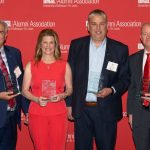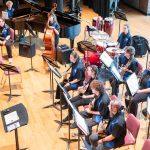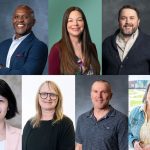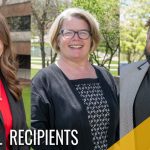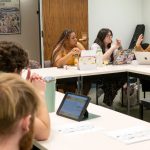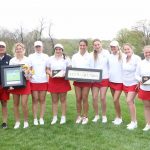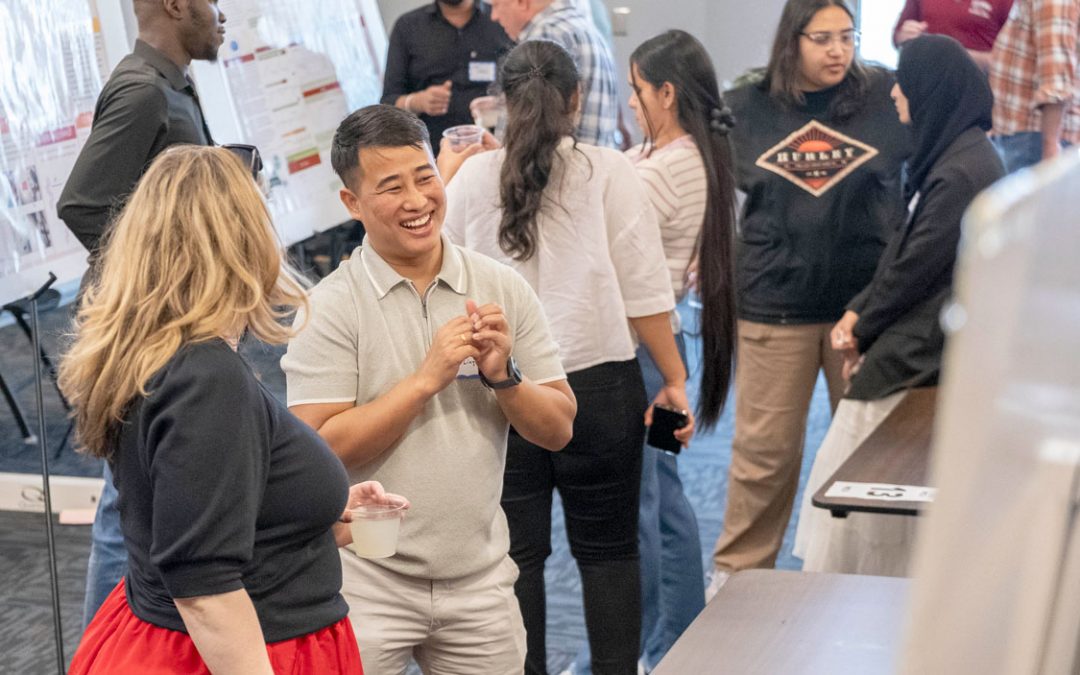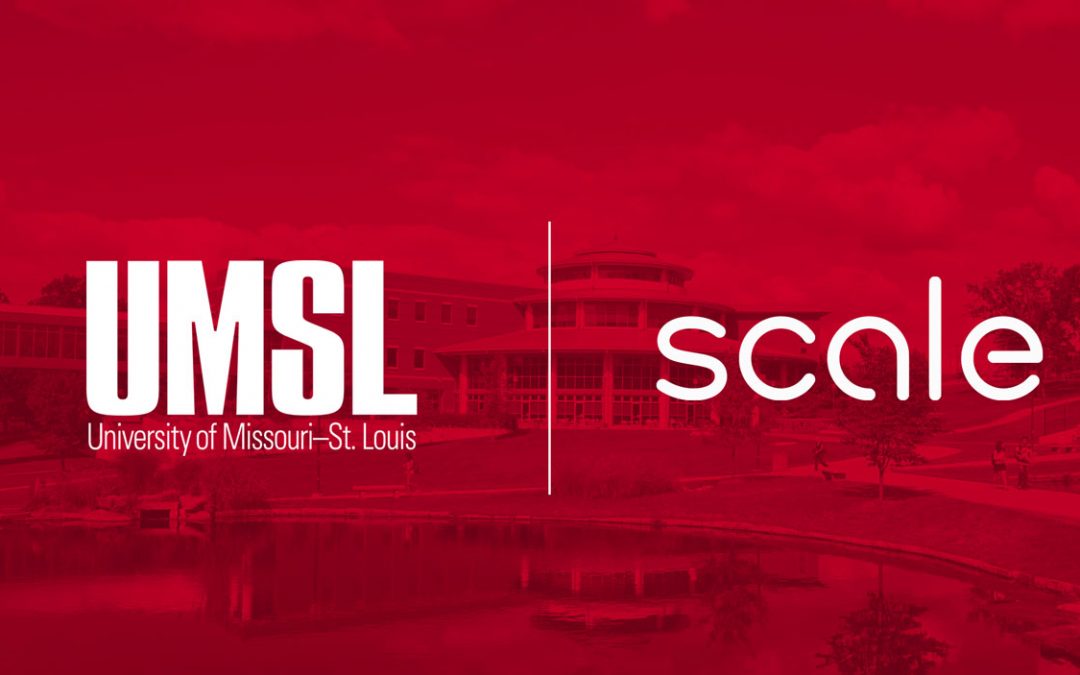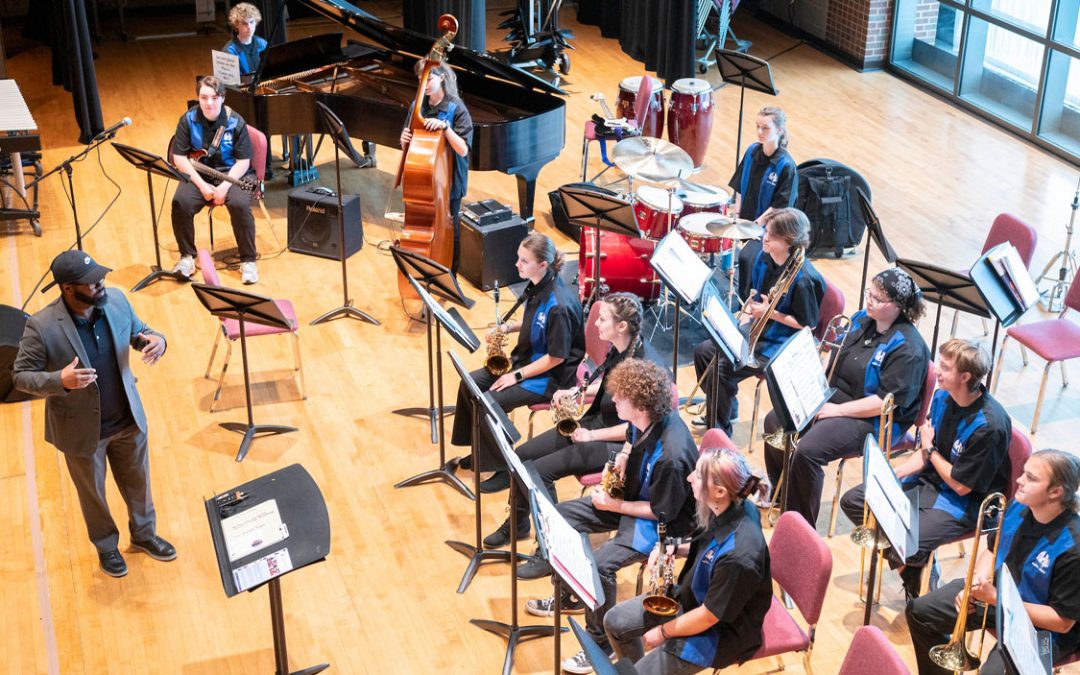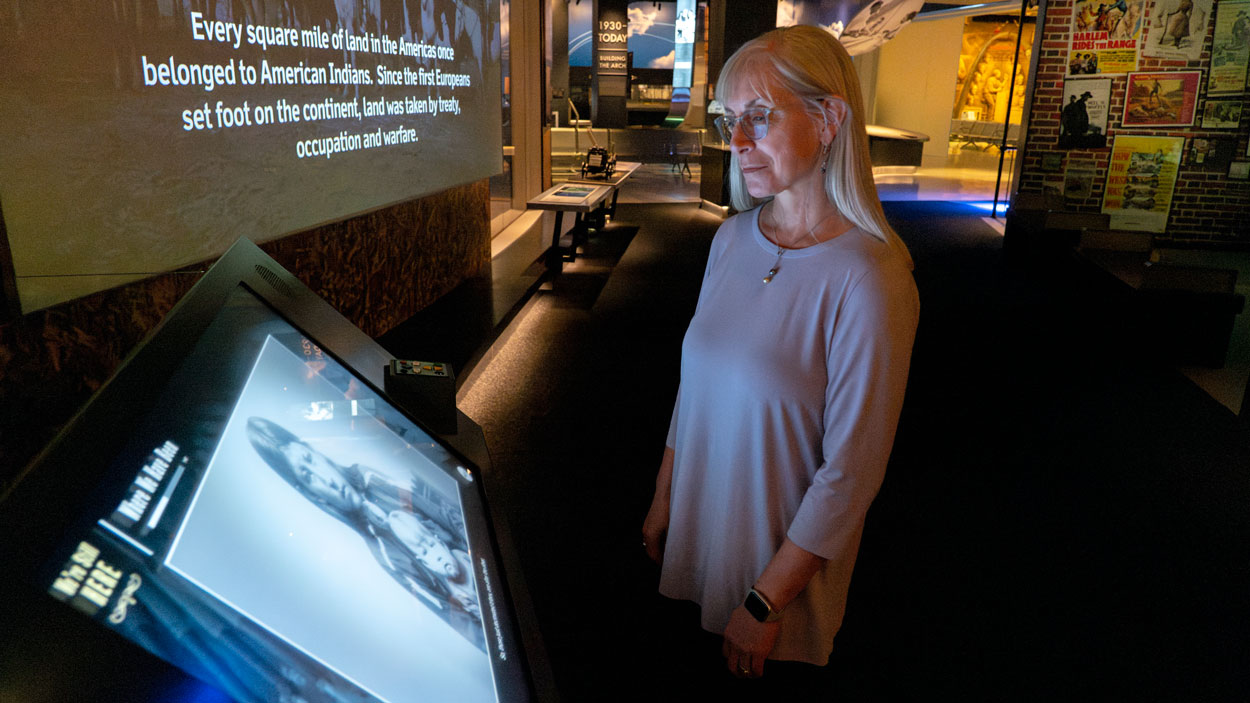
Theresa Coble examines an exhibit at the Museum at Gateway Arch National Park, which showcases more than 200 years of St. Louis history. Coble, the E. Desmond Lee Endowed Professor of Experiential and Family Education, is co-chairing the Committee on Recognizing Women’s History. (Photos by Derik Holtmann)
Last year, Theresa Coble found herself reaching new heights in an already impressive career.
In May, United States Secretary of the Interior Deb Haaland appointed Coble to the National Park System Advisory Board. Coble, the E. Desmond Lee Endowed Professor of Experiential and Family Education at the University of Missouri–St. Louis, described the appointment as “the honor of a lifetime.”
Understandably, she thought an “honor of a lifetime” would be difficult to top, but this May, she was presented with yet another extraordinary opportunity. Haaland tapped her to co-chair a committee in response to President Joe Biden’s Executive Order 14121 recognizing and honoring women’s history.
“You’re hoping as a board member to do work that influences the future trajectory of our national parks, meets known needs, and speaks to directions that not only an agency, but the whole Department of Interior could pursue,” Coble says. “You don’t know when you take a position on a federal advisory committee whether such opportunities will surface, and yet, in this case they did.”
The Committee on Recognizing Women’s History will work toward improving the recognition of women’s history across federal parks, lands and programs, including through park and national monument designations. Their recommendations will also inform the Department of the Interior’s actions over the next 10 years.
During an event in Washington, D.C. celebrating the initiative, Haaland and National Park Service Director Chuck Sams underscored the importance of recognizing untold, lesser told and purposefully excluded stories.
“The National Park Service is entrusted with using the power of place to tell the story of our country,” Sams said in a press release. “As we approach the 250th anniversary of the Declaration of Independence and its vision for equal rights and self-determination, the National Park Service is committed to sharing a fuller and more inclusive account of our nation’s history, a history that is not complete until all voices are represented.”
The committee’s preliminary recommendations are due to hit the president’s desk by December – a relatively tight timeline for a federal project. However, if there’s anyone suited to the task at hand, it’s certainly Coble.
***
Coble, who earned a PhD in forest resources from the University of Minnesota, has dedicated more than two decades to advancing the mission of the National Park Service through interpretation – an educational discipline that helps people pursue meaning-making and facilitates connections at informal learning sites such as national parks, museums and zoos.
She began partnering with the NPS in the 1990s, conducting research and engaging in interpretative project work at more than 25 national parks, including crown jewels such as Arches National Park and Yellowstone National Park. Locally, she’s supported the Gateway Arch National Park as secretary on the board of directors of the Jefferson National Parks Association. The National Association for Interpretation recognized her contributions to the field in 2019, bestowing the organization’s prestigious Fellow Award.
Coble has also transformed the lives of students from all walks of life – including several NPS park rangers – during her tenure at UMSL. After arriving at the university in 2015, she founded the innovative online Heritage Leadership EdD cohort in the College of Education. Under her leadership, students explore topics related to sustainability, social justice and participatory culture, and the program has grown considerably.
In 2022, Coble brought former NPS Director Robert Stanton – the first Black director in the bureau’s history and the first director to be confirmed by the U.S. Senate – to UMSL to serve as a scholar-in-residence in the College of Education, working directly with the doctoral cohort.
“I have enjoyed it immensely,” Stanton says. “It’s a privilege to work with Dr. Coble, who helps students wrestle with our contested heritage while also facilitating experiences for others that deepen understanding, broaden perspectives, and inspire engagement with the world around us. I stand in awe of her energy, her dedication, her intellect and her leadership toward the development and mentoring of the cohort in Heritage Leadership. It’s a wonderful experience.”
***
Breece Robertson, a leader in conservation geospatial technology and author of “Protecting the Places We Love,” seconds Stanton’s sentiments. Robertson met Coble serving as a fellow National Park System Advisory Board member and is co chairing the committee with her. Robertson was immediately drawn to Coble’s openness and her ability to tackle complex issues – useful skills in their current endeavor.
“Theresa’s in-depth knowledge of interpretation and education, and her longtime boots-on-the-ground experience working with communities and the National Park Service on complex and oftentimes difficult issues, are so important to leading this committee,” Robertson says. “She puts collaboration and partnerships first and foremost and is a great synthesizer of vast amounts of information and data.”
In selecting members for the committee, Coble and Robertson cast a wide net with the aim of bringing a diversity of experience from many sectors, cultures and worldviews to the project.
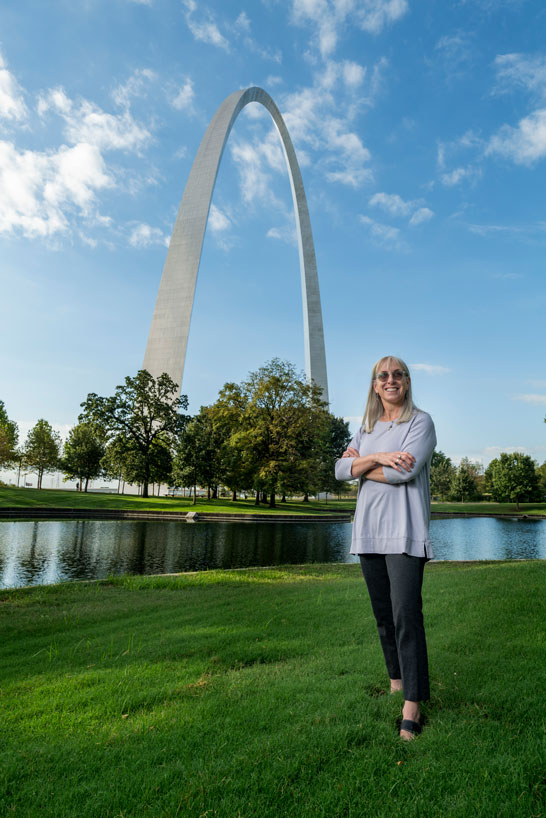
Theresa Coble has supported the Gateway Arch National Park as secretary on the board of directors of the Jefferson National Parks Association.
The committee includes Heather Ahtone, director of curatorial affairs at the First Americans Museum; Tanya Baker, executive director of the National Writing Project; Aja DeCoteau, executive director of the Columbia River Intertribal Fish Commission; Anna Danziger Halperin, associate director of the Center for Women’s History at the New York Historical Society; Stephanie Hull, president and CEO of Girls Inc.; Robert Keiter, founding director of the Wallace Stegner Center for Land, Resources and the Environment; Arlisha Norwood, assistant professor of history at the University of Maryland Eastern Shore; and Lindsay Robertson, Chickasaw Nation endowed chair emeritus in Native American law and professor emeritus of law, history and Native American studies at the University of Oklahoma.
By including these voices in the decision-making process, Coble hopes to develop recommendations that will allow the committee to accomplish their core charge, “to identify ways to improve the recognition of women’s history” at federal sites nationwide. That will require fundamentally reexamining the status quo.
“What are new strategies that can be used to bring women’s history into more places and help more people become more aware?” Coble says. “The question of untold, lesser told or purposefully excluded stories of women and girls, that’s another focus area for us. How do we make sure that there’s an inclusive narrative that’s being told about women in our nation’s history? Recently, I heard that only about 7% of the content in K-12 history textbooks is about women – and of that, 60% of the passages are about women’s domestic life. This under-representation, and I’d say misrepresentation, leads to societal blind spots about how women have shaped our nation and our public sphere.”
The country’s abundant Indigenous history offers many avenues of exploration, she notes, such as the Haudenosaunee people’s matrilineal kinship system and the influence it had on early suffragettes. The story of sisters Sarah and Angelina Grimké – among the first prominent white women to advocate for the abolition of slavery – also comes to mind.
***
Existing NPS sites offer plenty of opportunities to expand narratives and tell more nuanced stories. Coble points to the country’s many Civil War battlefield sites. Traditionally men – infantry soldiers, generals, politicians – have been featured, but women also played integral roles during that period. They served as civilian volunteers, de facto business managers, nurses and writers, standing in solidarity with their male counterparts.
Connecting sites thematically throughout the country to provide visitors with a fuller picture of history is also an exciting proposition.
“My sense is that we might recommend tying together federal entities that have rich or unique women’s history elements, creating something that’s beyond just a single heritage site, something that nudges people to migrate from site to site to site,” Coble says. “Some things are unique, but some things are cumulative and additive in ways that the sum is greater than its parts. You could design a planned sequence of activities or experiences so that people can move from place to place and each stop adds a new piece, adds some depth and richness, or brings a previous insight into a new context. These thematic ties would etch ever-deeper arcs of awareness into the hearts and minds of visitors.”
Coble believes digital interfaces will be crucial to visitor experiences over the next decade, as well. She sees potential for technologies like augmented reality and virtual reality to supplement more traditional interpretive techniques.
“I love our imagination, and I think there are lots of ways to bring history to life in our mind’s eye,” she says. “AR and VR are pretty cool. In St. Louis, at Gateway Arch National Park, you can explore the stories of three people who had a connection to the 1850s Mississippi riverfront: Anna Hormann immigrated to St. Louis from Bremen, Germany; James Eads designed a ‘submarine’ to salvage cargo from sunken steamboats; and John Parker was an enslaved dock worker who loaded and unloaded steamboats to make money to buy his freedom. VR makes their stories and that time period come alive.”
***
Coble and Robertson realize that December will arrive before they know it, but they’re confident in the headway the committee has made. The group is laying the groundwork for recommendations and has heard from subject matter experts in key topic areas.
“I’m really excited to be a part of bringing those untold, lesser known and purposefully excluded stories to light,” Robertson says, “so that girls and women can see themselves in the history of our country and that insight gives them inspiration to continue to be the amazing changemakers that we are.”
Coble knows interpreting those stories from the past – finding value in them – is the best way to build a better future.
“Interpretation is such a powerful discipline,” she says. “It’s a way to connect people with places, events and ideas. Interpretive experiences prompt us to consider more carefully the patterns that play out in our history, the mindsets that have brought us to where we are and the problems we now face. They’re antecedents – the past is prelude – and maybe national parks can help us learn some strategies and approaches to address injustice. Maybe they’ll motivate us to achieve those ideals that we espoused in our founding documents. Or maybe they’ll help us ask more meaningful questions. Better yet, interpretation can reach people at every stage of their life span, and in the modern era, we need lifelong learning.”
This story was originally published in the fall 2024 issue of UMSL Magazine. If you have a story idea for UMSL Magazine, email magazine@umsl.edu.



